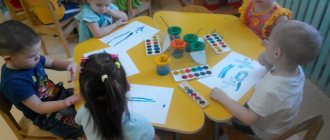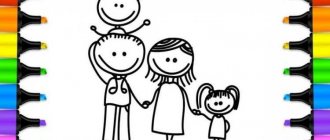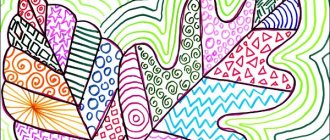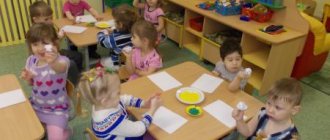Notes on non-traditional drawing "On a mushroom meadow" in the junior group
Lyudmila Pasikova
Notes on non-traditional drawing "On a mushroom meadow" in the junior group
Drawing foam rubber printing using a stencil
"In the mushroom meadow "
Program content: Teach children to depict mushrooms using a stencil using the “printing”
foam stick.
Practice drawing vertical short straight lines with your finger from top to bottom to depict grass. Develop a sense of color and rhythm. Cultivate curiosity and interest in drawing .
Materials, tools, equipment: illustration depicting mushrooms , stencils of mushrooms , sample teacher, foam sticks, sheets of A-4 paper, gouache, napkins.
The teacher shows an illustration of mushrooms and reads a poem:
We'll go into the woods, we 'll find a fungus ,
Small, okay, in a smart hat. (O. Vysotskaya)
Don't hide, mushroom in the grass ,
I'll rip you off anyway!
Examines parts of the mushroom , specifies color and size.
Then he turns his attention to the sheets of stencils. “You have mushrooms living in your clearing . But where are they? They hide behind the windows. Let's find them together? I dip the stick into the white paint and tap it on the “window”
.
Like this. Knock-Knock! Try it yourself.” Children accompany their movements with the words: “Knock-knock-knock
.
The teacher helps fill out the entire lower part of the window. mushrooms lack ? Now let’s fill the upper part of the “window”
. At the end of the work, the stencils are removed. The teacher reads a poem:
Look, mushrooms have appeared !
Brown cap, solid belly
You see, this is dad, it’s easy to recognize him.
We tried our best and found mushrooms in a green meadow .
Summary of a lesson in the junior group of kindergarten on the topic: Mushrooms hide in the grass
ABSTRACT
CLASSES IN THE JUNIOR GROUP
ON THE TOPIC: “MUSHROOMS HIDDEN IN THE GRASS.”
KIND OF ACTIVITY:
painting with gouache paints.
Subject:
"Mushrooms are hiding in the grass."
Program content:
1. Teach children to depict mushrooms in two parts: the stem is vertical stripes, the cap is half a circle.2. Strengthen the ability to paint over a hat, repeating the outline of the drawn figure.3. Arouse interest in creating the composition “Mushrooms in a clearing.”4. To foster in children a love and interest in nature.
Preliminary work:
Reading poems and guessing riddles about mushrooms, looking at illustrations depicting mushrooms and studying their dummies, drawing up an image of a mushroom on a plane from parts (leg and cap), showing analogies (umbrella, children's sandbox, table lamp). Modeling mushrooms from plasticine and salt dough. Game exercises for drawing elongated ovals and halves of a circle.
Dictionary:
cap, stem, circle, oval, half circle.
Individual work with children:
___________________________________
__________________________________________________________________
Teaching methods and techniques:
visual: sample, display, analysis of children's work; verbal: examination, explanation, artistic expression; gaming: game moment, surprise; practical: drawing exercises.
Materials and equipment:
watercolor paints, sheets of blue paper, equipment for painting with paints.
Visual range:
Computer presentation on a given topic. Mushroom dummies, basket. Toys - squirrels. The teacher has a sheet of paper to show drawing methods, figures of two or three squirrels, a picture depicting edible and inedible mushrooms. Variants of compositions “Mushrooms”, cardboard oval and circle. A set of technology cards for drawing mushrooms.
Sound series:
children's songs “About Mushrooms”, “For Mushrooms”.
Duration:
15 minutes.
KIND OF ACTIVITY:
painting with gouache paints.
Subject:
"Mushrooms are hiding in the grass."
Program content:
1. Teach children to depict mushrooms in two parts: the stem is vertical stripes, the cap is half a circle.2. Strengthen the ability to paint over a hat, repeating the outline of the drawn figure.3. Arouse interest in creating the composition “Mushrooms in a clearing.”4. To foster in children a love and interest in nature.
Progress of the lesson:
You guys and I will go to the autumn forest. Let's close our eyes tightly, tightly, our eyes opened, we circled around ourselves and found ourselves on a forest path.
We are walking along paths
We are walking paths
We are going with baskets
We are going with baskets
The squirrels come running, greet the guys, and offer to guess a riddle about what they love most:
“Under the pine tree by the path, Who stands among the grass, There is a leg, but no boot, There is a hat, but no head.”
They say that many mushrooms grew in their forest. And winter will soon come, and if they do not stock up on good mushrooms for the winter, they will starve. But they don’t know which mushrooms are good and which are poisonous and ask the guys to help them figure it out. Children help the squirrels sort the mushrooms into two piles: edible and inedible, and at the same time repeat the names of the mushrooms. The best mushrooms are porcini mushrooms. They have brown caps and white legs.
Physical exercise “For mushrooms”
All the little animals at the edge of the forest are looking for milk mushrooms and milk mushrooms. The squirrels were jumping, the squirrels were plucking. The fox ran, the foxes collected. The little bunnies were jumping around, looking for honey mushrooms. The bear passed by and crushed the fly agaric.
Children walk in a round dance. They jump up and down and pick imaginary mushrooms. They run in a circle, collecting imaginary mushrooms. They jump while standing, picking imaginary mushrooms. They waddle, then stamp their right foot.
V. Nishcheva
The teacher puts the picture in front of the children and turns to the squirrels: don’t worry, squirrels, the children and I were just about to draw a lot of porcini mushrooms in the forest. I will now show you how to draw porcini mushrooms.
Sequence of work:
Drawing small white mushrooms:
— using white paint, we apply vertical strokes, applying the entire bristles of the brush to the paper, the legs are straight; - rinse the brush well, dip its bristles in brown paint; - using a horizontal stroke on top of the legs, draw caps to the legs. The legs stand, and the hats lie on them.
Drawing large mushrooms:
- the stem of the mushroom is oval, draw it using your palm, first outline your hand with a simple pencil, and then paint it with a brush.
- hat - a semicircle, half a circle, draw a horizontal line above the leg and draw half a circle, color it according to the shape.
— the cap can be brown or red.
— we finish painting the grass with a brush and strokes.
Finger gymnastics “Mushrooms”
This finger went into the forest, This finger found a mushroom, This finger began to clean, This finger began to fry, This finger sat down and ate, That’s why it got fat.
During the lesson, the teacher, on behalf of the game characters, encourages the children to draw mushrooms carefully. Squirrels praise those mushrooms in the drawings that have straight legs and caps (the strokes are laid vertically and horizontally).
At the end of the lesson, the drawings are placed on the stand close to each other. The squirrels admire the large forest, which is full of porcini mushrooms.
Then the squirrels call several children to help them find strong porcini mushrooms that can be stored for the winter.
It's time for us to go back to kindergarten. We walk along the paths
We follow paths.
We close our eyes, open them,
Turned around themselves
And they returned to kindergarten.
On the topic: methodological developments, presentations and notes
Target. Teach the technique of smearing, i.e. pressing on the rolled ball with your index finger and pulling it up to obtain an image of grass; continue to teach yourself how to pinch off small ones.
Educational areas: cognition, communication, physical development. Goal: to consolidate and expand children’s ideas about spring, to cultivate a caring attitude towards nature; development of fine motor skills of the hands, development of...
Summary of a finger painting lesson in the first junior group Topic: “Let's decorate the Christmas tree” Types of children's activities: playful, communicative, cognitive-research, productive.
Summary of a finger painting lesson in the first junior group “Beautiful cup with polka dots” Irina Shishkina Summary of a finger painting lesson in the first junior group “Beautiful cup.
a lesson on sensory development on the topic “magic meadow”.
Learn to draw in unconventional ways - with your fingers.
Source
How to draw a fox?
Chanterelles are different in appearance from most other mushrooms. It may be yellow or orange. They have an irregular shape: the edges are wavy, curved towards the bottom. The cap is almost completely fused with the stem. Such mushrooms grow in almost every forest. More often found near oak, birch or pine. Having learned a few distinctive features, you can begin to depict it on paper in stages.
- We make the outline of the mushroom. To make it beautiful, you need to draw two auxiliary lines: one horizontal, the second vertical, slightly tilted to the side.
- We add two slashes to the vertical line. This will be the base of the leg. Now we draw two lines up, gradually expanding them. The result is a shape similar to a cup.
- To give the top its own shape, draw an elongated and uneven oval. It should protrude slightly to the sides.
- We remove all auxiliary lines. Under the cap we draw, a little with a slight slope, a lot of vertical stripes. Draw the grass using sharp triangles.
- All that remains is to color everything. We outline the outline in brown, lightly shading the mushroom itself. Make the sides more saturated. Add orange to the top of the leg. The grass is green. This is how easy it is to draw a fox with a pencil, following a step-by-step plan.
Application with drawing elements “Mushroom clearing” in the second junior group
Liliya Nasretdinova (Fatiykhova)
Application with drawing elements “Mushroom clearing” in the second junior group
Author : Liliya Nasikhovna Fatykhova, teacher of the first qualification category of MADOU No. 100 “Firebird”
city of Naberezhnye Chelny.
Goal: to develop imagination and interest in artistic creativity.
-learn to depict mushrooms using the appliqué technique : create images of contrasting sizes from ready-made elements;
— enrich children’s vocabulary and develop their speech;
— practice the technique of painting with gouache paints .
- cultivate curiosity and interest in nature;
- stimulate children's creative activity;
- cultivate independence, confidence, initiative.
— Develop communication skills, cognitive processes (mental operations, arbitrariness and concentration, memory capacity and others).
— Maintain children’s interest in the discipline being studied.
— Develop a sense of color, shape, size and composition.
Materials, tools, equipment.
Sheets of white paper for composing the composition, ready-made forms for gluing mushrooms - rectangular or oval legs and round or semicircular caps (2 sets of elements each, contrasting in size, glue, 2 brushes, gouache paints, cups (jars)
with water, paper and cloth napkins, oilcloths.
White King
Let's start with the simplest and most popular option. You can draw with your child. To do this, you should prepare: simple and multi-colored pencils, plastic.
- We draw the contours of the mushroom. We make the head semicircular, and add an elongated oval at the bottom. This is a leg.
- Next we draw the same one, only smaller in size. We are engaged in drawing contours and details. At the bottom of the cap we draw an arc separating its top. The line indicates the location of the beginning of the leg.
- Make the contours of the small mushroom clearer. We remove all auxiliary dashes. For a beautiful look, add grass. It may slightly overlap the main part.
- Now you can start coloring. The tops will be brown. Show a little light highlight. We make the base gray and the grass green. Paint the bottom of the cap with pale yellow paint. The drawing is ready.
fly agaric
This is the leader of the inedible mushrooms. Despite its beautiful coloring, it is strictly forbidden to eat. To draw it, you need to choose only bright shades of pencils. It is better to use watercolors. Additionally, you will need a black gel pen and an eraser. Let's get to work. We will depict a family of three representatives of the species.
- We draw three contours of future legs. The tallest one should be in the center.
- Adding hats. Fly agarics of different sizes have different shapes. For the central one, we make a circle with wavy edges at both the top and bottom. For the left mushroom, draw a circle and add an arc on top, dividing the entire cap into two parts. The top half is much smaller than the bottom. For the right one - a small elongated oval.
- Adding details. It is necessary to show folds on the legs: some in the center, others in several rows at the bottom. Add plates under the mushroom caps.
- We draw white dots on the head using circles of different sizes. Moss can be depicted below. Now everything needs to be outlined with a black pen. After it dries, remove all pencil lines.
- Let's color the picture. We make the legs gray. The cap plates are the same color. We use brown to show shadows. The hat consists of three layers of color. The top is orange. The edges are burgundy and the central part is red. We correct everything with smooth transitions. Paint the moss with a dark green shade. The work is completed.
Honey mushroom family
Small mushrooms with round caps are always arranged in groups. They grow on green meadows and stumps. Every mushroom picker loves these fragrant babies. When starting to depict these beauties, it is better to look at them in person. After all, it is so unusual for them to gather in friendly companies. But, if this is not possible, you can look at the photo and make our step-by-step lesson.
- Let's draw a cylinder - this is the future stump. We mark the location of the mushrooms with thin lines. Two will be at the bottom left, and a group of five will be at the top right on the edge of the stump.
- We thicken the legs. We draw semi-oval caps.
- Now we color the work with colored felt-tip pens. The mushrooms themselves will be light brown. Don't forget to show the skirt under the hat and on the leg. The stump is dark brown in color. The top of the cut is yellow.
- We add a little yellow to the mushroom itself, showing the transition from dark to light areas. We darken the bottom of the stem of each honey mushroom.
- Draw the roots of the stump and the grass.
You can make a drawing unique by adding just a little bit of your vision. Even following our general step-by-step master classes, each person’s paintings will be different. And that's great. After all, every video world is different.





